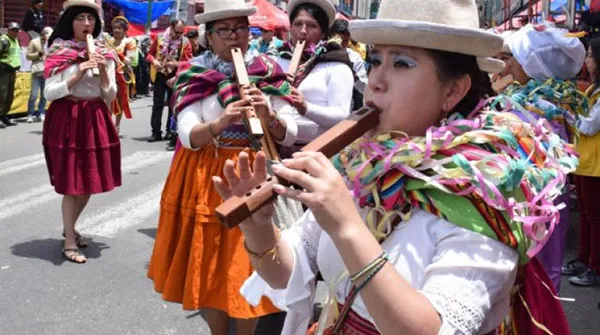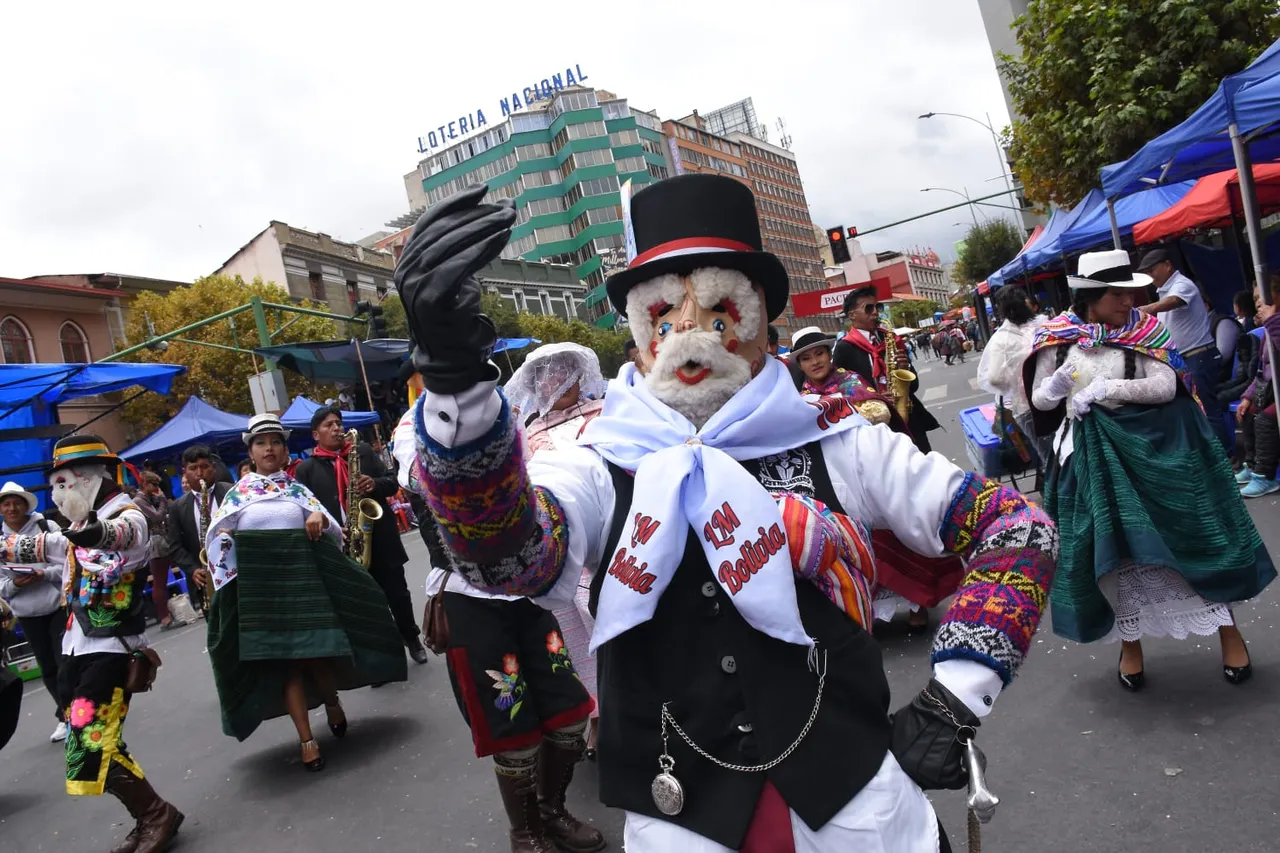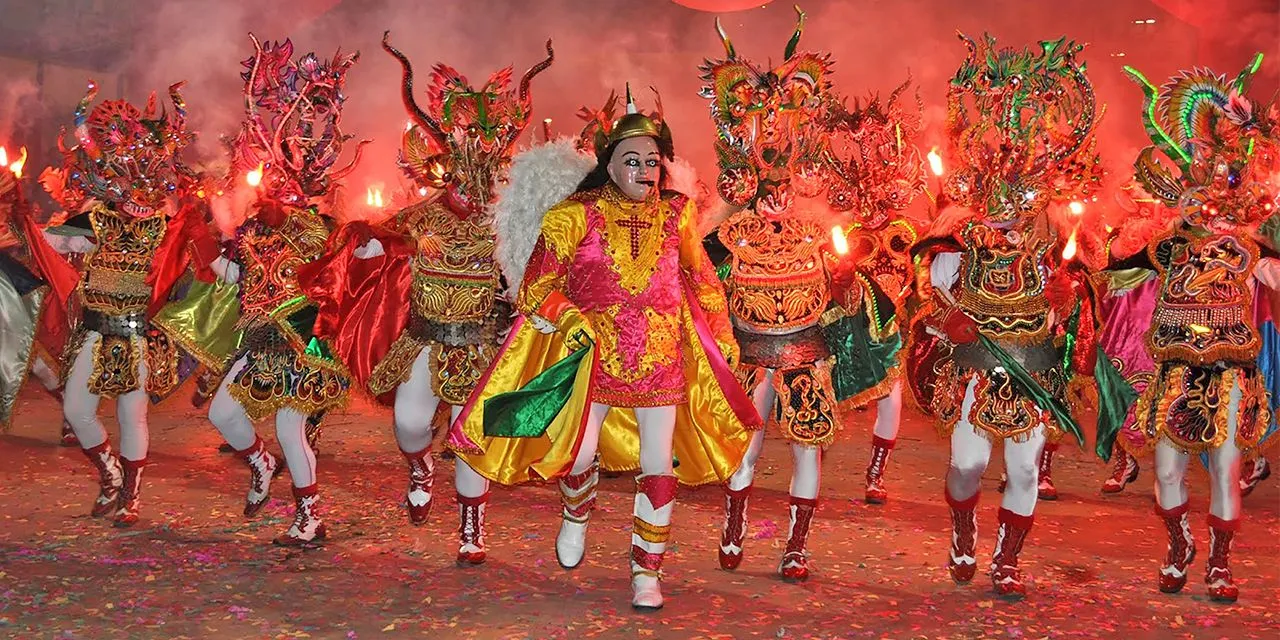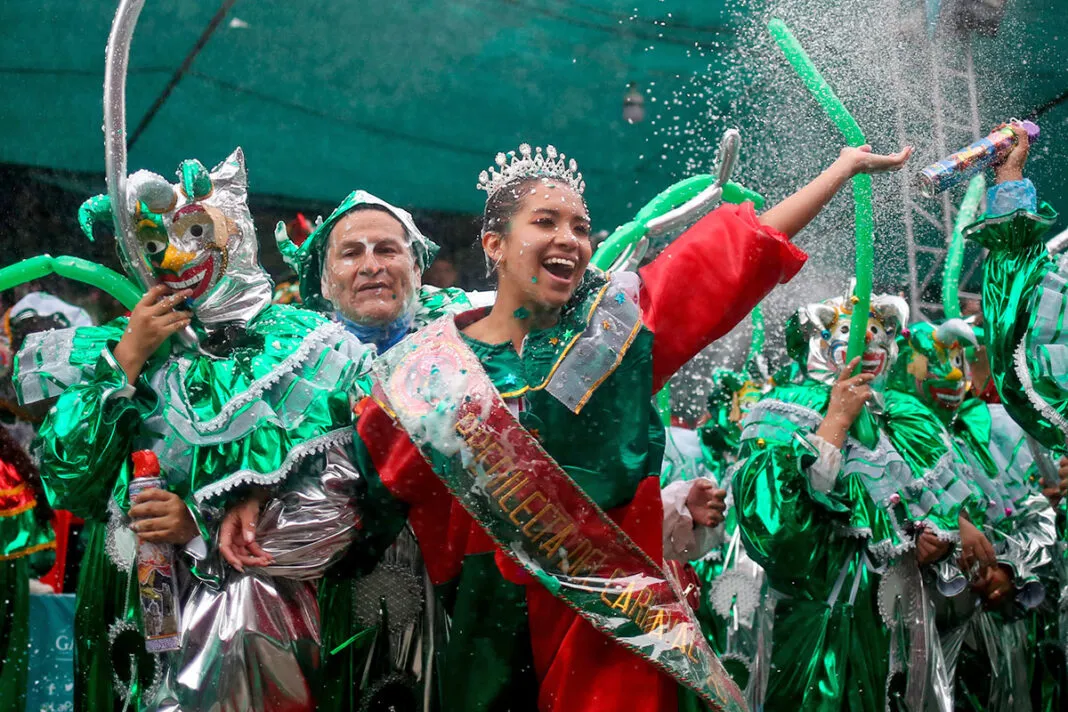INTRODUCTION
In every country, in every city the days of carnival are lived in a different way, and my country is no exception, today I want to tell you a little about how carnival is lived in Bolivia.
It is one of the most important celebrations in South America since many foreigners come to witness our culture, because also one of these carnivals was recognized by UNESCO as Intangible Cultural Heritage of Humanity.

Source: ATB Digital
ORIGIN AND HISTORY
Carnival in Bolivia has pre-Hispanic roots and merged with Catholic traditions during colonial times. Before the arrival of the Spaniards, Andean peoples performed rituals in honor of their gods to ask for prosperity and to give thanks for the harvest. With colonization, these ceremonies were mixed with Christian festivities, giving rise to a celebration that combines the sacred and the festive.

Source: Wikipedia
This is something very common that has happened in several countries of the region, to have this mixture of traditions with the Spanish ones, but I believe that each country has known how to adapt it so as not to lose its own culture.
But it also varies from city to city, with is the case of Oruro, La Paz, Tarija, Sucre, Cochabamba of the most interesting to live and know.
OUTSTANDING CARNIVALS IN BOLIVIA
Of the ones I have already mentioned, I would like to talk about the most representative and the ones I like to celebrate the most:
Carnival of Oruro, the largest and best known worldwide. In this festival more than 60,000 dancers, 20,000 musicians and 350,000 spectators, including locals and international tourists (according to national information). In this carnival different dances are danced that have a history and tradition behind, the ones I like the most are the Diablada, the Tobas, the Caporales, the Morenada among others.
Carnival of La Paz, in the city where I live there are also different dances, in this case it is called the Jisk'a Anata a La Paz celebration where a large number of dancers also meets with different stories and traditions behind. Such as: ch'utas, tarqueadas, morenada, wakas wakas and more. Here are some images of the costumes.

Source: Bolivia Popular

Source: La Razón
- Carnival in Tarija, Sucre, Cochabamba and others. Other cities in Bolivia also have different traditions such as having specific days where men (compadres) and women (comadres) celebrate. Or where they live carnivals of yesteryear, as they were lived in the times of the Spanish conquests. And also others where they dance and dress up in whatever they want to go out to get wet and form comparsas.

Source: Sucre

Source: Opinión
All these festivities have their unique touch that is worth knowing, living and enjoying, I hope you also get to know my country and even more so during carnival season.
DANCES AND MUSIC
As I had mentioned, there are different dances that can be appreciated during these festivities, of which the ones I like the most and would like to tell you a little more about are:
- The Diablada, is a dance that represents the confrontation between good and evil, mixing elements of the Catholic religion introduced during the Spanish conquest and traditional Andean rituals. Among the characters are: Lucifer, Satan, the Devils, the Archangel Michael Archangel, the China Supay, the Condors and Bears.

Source: Ahora El Pueblo
- The Tobas, this acrobatic dance expresses the feeling of warrior and hunting attitudes, with athletic jumps and turns that emulate the throwing of spears at the enemy or prey, also showing stealth and stalking.

Photo by Juan Manuel Cuellar Carpio on Facebook
What fascinates me most about these dances is partly their history, but also the costumes they wear, it is quite an experience to see them live and direct.
TRADITIONS
There are also other interesting traditions, the best known of which is the Tuesday of ch'alla, a tradition where families thank the Pachamama, Mother Earth, for the goods received and ask for prosperity for the future. During this celebration, houses, cars and businesses are decorated with balloons, streamers, candies, flowers and flags, and alcoholic beverages such as wine or beer are sprinkled in the corners of the properties to give a drink to Pachamama and ask for her protection and blessing.

Source: Eju!
This tradition comes from a long time ago, which was related to agriculture, in which they thank the earth for the fruits received and invite the Pachamama with offerings and gifts.
And another, the best known of all where they play with water and foam, although I think this does not have a history behind it, I think that since long ago it has generated a nice custom where children and adults can have fun.

Source: Jornada
TIPS FOR TRAVELERS
For those people who want to visit my country on these dates, I have some advice, if possible try to buy a travel package that already includes lodging, food, transportation and others. Also that you buy it well in advance because being a party so important and recognized worldwide, is highly demanded by tourists (talking about the Carnival of Oruro).
I also recommend that you organize a program to visit the other cities of Bolivia, such as La Paz, Tarija and Cochabamba to learn about their traditions during the carnival.
Something that is always mentioned to us during these dates is that one almost never sleeps because there are so many activities that can be done and everything happens in a matter of days. That is why they recommend to be well rested, go with friends and family who really want to enjoy and learn about our culture.
And above all take comfortable clothes, something warm and be prepared because it is almost certain that you will end up wet and foamy all over, because here the game is serious.
And finally, have battery and space on your cell phone to take the best pictures and also take advantage of posing with the dancers because it is something amazing.
I hope that like me, you have been left with that curiosity and that desire to visit us in a next carnival because I assure you that you will have a lot of fun and it will be a unique experience that you will live in Bolivia.

Source: Ministerio de Culturas
VERSIÓN EN ESPAÑOL
Carnaval de Bolivia: Un viaje entre danzas, tradiciones y aventura
INTRODUCCIÓN
En cada país, en cada ciudad se vive de forma distinta los días de carnaval, y mi país no es la excepción, hoy quiero contarles un poco de cómo se vive en Bolivia el carnaval.
Es una de las celebraciones más importantes a nivel Sudamérica ya que vienen muchos extranjeros a presenciar nuestra cultura, porque además uno de estos carnavales fue reconocido por la UNESCO como Patrimonio Cultural Inmaterial de la Humanidad.

Fuente: ATB Digital
ORIGEN E HISTORIA
El Carnaval en Bolivia tiene raíces prehispánicas y se fusionó con las tradiciones católicas durante la colonia. Antes de la llegada de los españoles, los pueblos andinos realizaban rituales en honor a sus dioses para pedir prosperidad y agradecer las cosechas. Con la colonización, estas ceremonias se mezclaron con festividades cristianas, dando origen a una celebración que combina lo sagrado y lo festivo.

Fuente: Wikipedia
Esto es algo muy común que ha pasado en varios países de la región, tener esa mezcla de tradiciones con las españolas, pero creo que cada país a sabido adaptarlo para no perder en sí su cultura.
Pero también va variando de ciudad en ciudad, con es el caso de Oruro, La Paz, Tarija, Sucre, Cochabamba de las más interesantes de vivir y conocer.
CARNAVALES DESTACADOS EN BOLIVIA
De los que ya mencioné me gustaría hablar de los más representativos y los que más me gustan festejar, está el de:
Carnaval de Oruro, el más grande y conocido a nivel mundial. En esta festividad se juntaron más de 60,000 bailarines, 20.000 músicos y 350.000 espectadores, entre locales y turistas internacionales (según información nacional). En este carnaval se bailan distintas danzas que de igual forma tienen una historia y tradición detrás, los que más me gustan son la Diablada, los Tobas, los Caporales, la Morenada entre otros.
Carnaval de La Paz, en la ciudad donde vivo se realizan también distintos bailes, en este caso se llama el Jisk’a Anata una celebración paceña donde también se reúne una gran cantidad de bailarines de igual forma con distintas historias y tradiciones detrás. Tales como los: ch’utas, tarqueadas, morenada, wakas wakas y más. Aquí les dejo algunas imágenes de los trajes.

Fuente: Bolivia Popular

Fuente: La Razón
- Carnaval de Tarija, Sucre, Cochabamba y otros. En las demás ciudades de Bolivia también se tienen distintas tradiciones como por ejemplo tener días específicos donde celebra los hombres (compadres) y las mujeres (comadres). O donde se viven carnavales de antaño, como se vivían en los tiempos de las conquistas españolas. Y también otros donde bailan y se disfrazan de lo que quieran para salir a mojar y armar comparsas.

Fuente: Sucre

Fuente: Opinión
Todas estas fiestas tienen su toque único que vale la pena conocer, vivir y disfrutar, espero que ustedes también se animen a conocer mi país y más aún en temporada de carnaval.
DANZAS Y MÚSICA
Como les había mencionado, hay distintas danzas que se pueden apreciar durante estas fiestas, de las cuales las que más me gustan y quisiera contarles un poco más son:
- La Diablada, es una danza que representa el enfrentamiento entre el bien y el mal, mezclando elementos de la religión católica introducida durante la conquista española y rituales andinos tradicionales. Dentro de los personajes están: Lucifer, Satanás, los Diablos, el Arcángel Miguel Arcángel, la China Supay, los Cóndores y Osos.

Fuente: Ahora El Pueblo
- Los Tobas, esta danza acrobática expresa el sentimiento de guerrero y actitudes propias de la caza, con saltos atléticos y giros que emulan el lanzamiento de lanzas al enemigo o a la presa, mostrando también sigilo y acecho.

Foto de Juan Manuel Cuellar Carpio en Facebook
Lo que más me fascina de estas danzas es en parte su historia, pero también los trajes que llevan, es toda una experiencia verlas en vivo y directo.
TRADICIONES
Existen también otras tradiciones interesantes, de las más conocidas que es el martes de ch’alla, una tradición donde las familias agradecen a la Pachamama, la Madre Tierra, por los bienes recibidos y piden prosperidad para el futuro. Durante esta celebración, se adornan casas, autos y negocios con globos, serpentinas, confites, flores y banderines, y se rocían con bebidas alcohólicas como vino o cerveza en las esquinas de las propiedades para dar de beber a la Pachamama y solicitar su protección y bendición.

Fuente: Eju!
Esta tradición viene de hace mucho tiempo atrás, el cual estaba relacionado con la agricultura, en los que se agradece a la tierra por los frutos recibidos y se invita a la Pachamama con ofrendas y regalos.
Y otra, la más conocida de todas donde se juega con agua y espuma, si bien esto creo que no tiene una historia detrás creo que desde mucho tiempo atrás a generado una bonita costumbre donde pueden divertirse grandes y chicos.

Fuente: Jornada
CONSEJOS PARA VIAJEROS
Para aquellas personas que quieran visitar mi país en estas fechas, les tengo algunos consejos, en lo posible traten de comprar algún paquete de viaje donde ya incluyan hospedaje, alimentación, transporte y demás. También que lo compren con bastante anticipación ya que al ser una fiesta tan importante y reconocida a nivel mundial, es muy demandada por los turistas (hablando del Carnaval de Oruro).
También les recomiendo que organicen un programa para poder visitar las demás ciudades de Bolivia, como La Paz, Tarija y Cochabamba para que conozcan sus tradiciones durante el carnaval.
Algo que siempre nos mencionan en estas fechas es que uno casi nunca duerme porque hay tantas actividades que se pueden realizar y todo ocurre en cuestión de días. Por eso recomiendan estar bien descansados, ir con amigos y familiares que realmente quieran disfrutar y conocer nuestra cultura.
Y sobre todo llevare ropa cómoda, algo abrigada y estar preparados porque es casi seguro que terminarán mojados y espumeados por todo lado, ya que aquí el juego es en serio.
Y por último tener batería y espacio en el celular para sacar las mejores fotos y aprovechar también en posar con los bailarines porque es algo asombroso.
Espero que como a mí, les haya quedado esa curiosidad y ese deseo de visitarnos en un siguiente carnaval porque les aseguro que se van a divertir mucho y será una experiencia única la que vivirán en Bolivia.

Fuente: Ministerio de Culturas